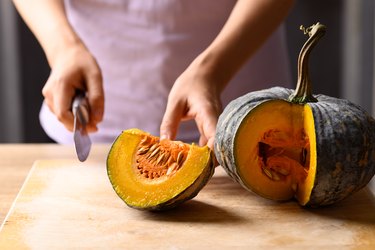
Worms in pumpkins (Cucurbita pepo), also called cucumber worms, are usually not worms at all, but the larvae of insects like the striped cucumber beetle and the squash vine borer. Borer larvae tunnel through the vines, causing the vines to collapse and the leaves to wilt, and beetle larvae feed on the roots. They may also spread diseases and, in severe cases, may wipe out an entire pumpkin patch. If you grow pumpkins for food, decoration or profit, there are several remedies for these annoying pumpkin pests. Once you identify what's eating your pumpkins, you can solve the problem.
Finding Squash Vine Borers
Video of the Day
The squash vine borer is the larva of the squash vine borer moth, which resembles a wasp more than a moth. This moth lays dull red eggs in spring among pumpkin, cucumber and squash plants. Adult moths typically have an orange abdomen with black dots and metallic greenish-black wings. Unlike most moths, the University of Wisconsin-Madison notes that they are most active during the daytime (diurnal) instead of at night (nocturnal).
Video of the Day
Squash vine borer larvae are creamy white with brown heads and grow to one inch long. When the larvae hatch, they tunnel into the developing vines. Their excrement appears as yellow, sawdust-like frass on the vines and soil. It becomes sticky and shiny with age.
Cut the vines open directly above an entry hole. Remove and destroy the larvae, and cover the vine with soil so it can heal and regrow. Treat pumpkins with pesticides in early summer at the first sign of an insect infestation. Once the larvae burrow into the vine, pesticides become ineffective.
The appearance of frass means that more eggs will soon be hatching. Spray the entire leaf canopy to kill newly hatched larvae, and apply a second application seven days later.
Identifying Striped Cucumber Beetles
Striped cucumber beetles are small, greenish-yellow beetles with three black stripes. They grow to only one quarter of an inch long and have a dark head and antennae. Their eggs are light yellow to orange. The larvae, like those of the squash vine borer, are creamy with a brown head, but they grow to only three-eighths of an inch long.
Striped cucumber beetle larvae tunnel into the soil and feed on the roots, although they may also eat the stems, leaves and fruit of pumpkins and other cucurbits. In addition to the damage they cause by eating the plants, they spread bacterial wilt, a serious disease that infects cucurbits. Monitor plants for signs of the adult beetles. Hand-pick them from the plants, and drop them into a bucket of soapy water.
Install floating row covers after planting so beetles don't have access to the plants. The University of Minnesota Extension reminds gardeners to remove the covers when the pumpkins start to bloom so bees can pollinate them. You an also hand-pollinate the flowers and keep the row covers intact.
Recognizing Pickleworms on Pumpkins
Young pickleworms look like a colorless or white to yellow worm with black head (or dark-brown heads) and brown spots across the abdomen. As the larvae mature, they turn yellowish-green. Adult pickleworm moths are brown with yellow markings, and they have a wing span of 1 1/4 inch and a small cluster of hairs on the tip of the abdomen. The moths lay pale white eggs directly on leaves.
Pickleworms feed on pumpkins, cucumbers and other squashes, causing damage ranging from minor cosmetic damage to severe damage, rendering the fruit unusable. Best strategies for how to get rid of pickleworms are planting pumpkins as early in the season as possible, and spraying them with a pesticide labeled for use on pumpkins in late summer if pickleworms are evident.
Management Options for Pumpkin Pests
Use pesticides judiciously in the pumpkin patch. Pumpkins and other squash are susceptible to damage from pesticides. Many pesticides also kill bees, which are needed for pollination and fruit development. Rotate pumpkin crops so they don't grow in the same place from year to year, and rototill the soil in the spring to destroy overwintering insects. Plant pumpkins on fertile soil in a sunny location. Healthy pumpkin plants are more able to recover from insect attacks.